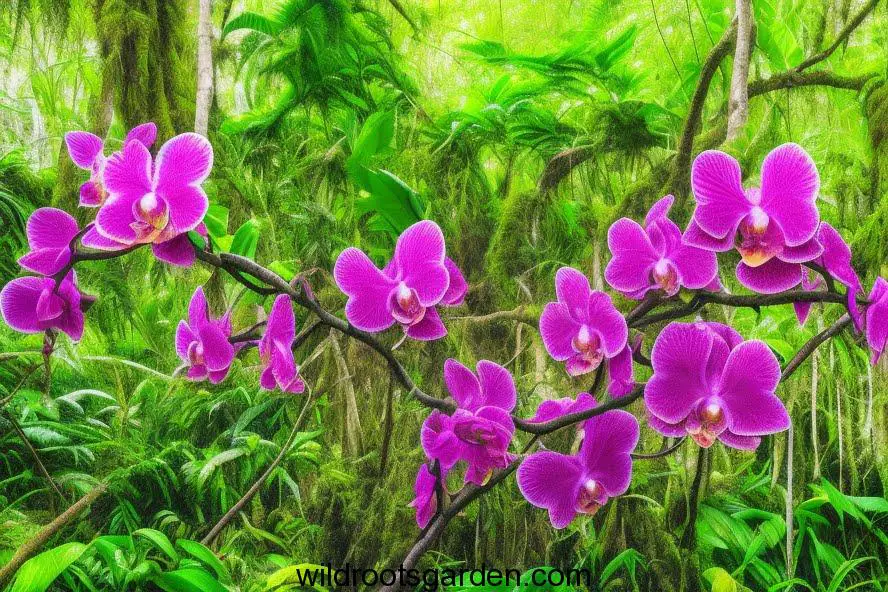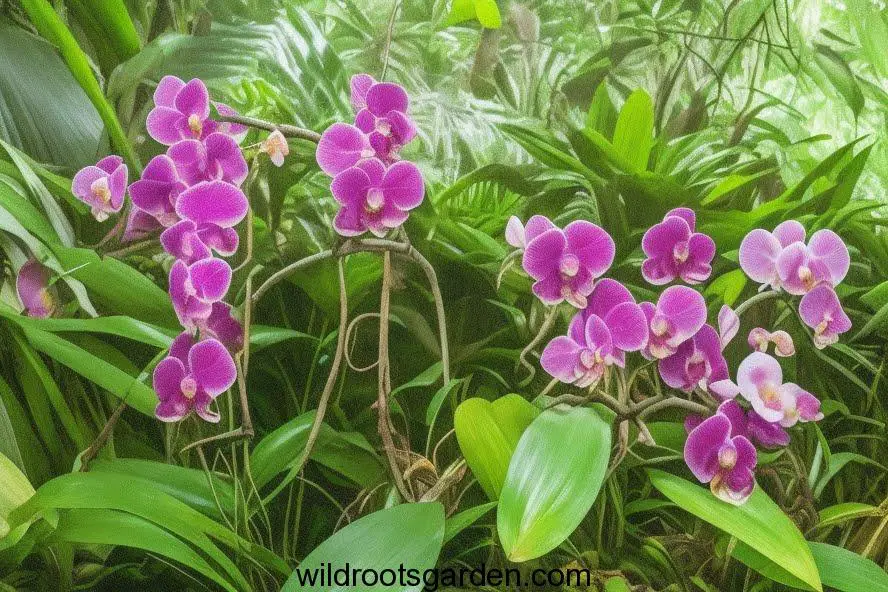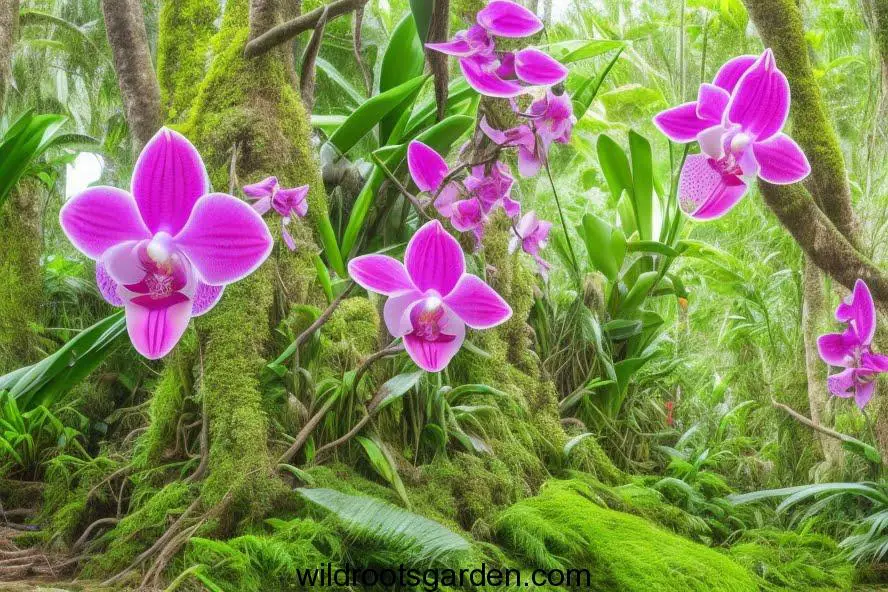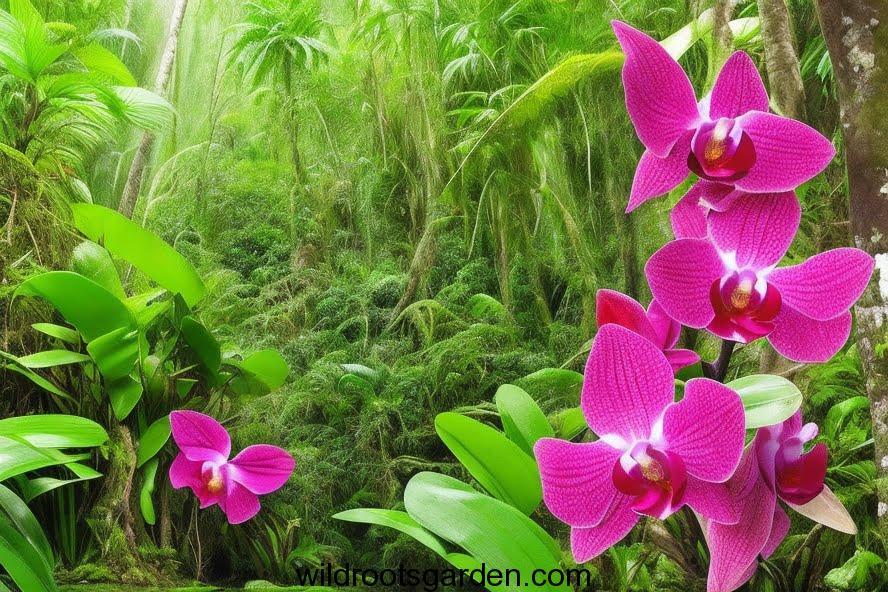Adaptations of Orchids in the Tropical Rainforest. A fascinating variety of orchids live in the lush depths of the tropical rainforest, showing an astounding range of adaptations that have enabled them to flourish in this particular environment. These graceful flowers, known for their stunning beauty and diversity, have developed clever coping mechanisms to deal with the difficulties of their environment. Orchids are prime examples of nature’s amazing capacity for adaptation and survival, from their air roots’ tenacious clinging to trees for support and nutrition absorption to their fascinating symbiotic partnerships with specialized pollinators. This investigation dives into the fascinating world of orchids and reveals the mechanisms that have allowed them to thrive in the rich biodiversity of the tropical rainforest.
What are Orchids?
The Orchidaceae family, which includes approximately 28,000 recognized species, is where orchids are classified. These are flowering plants noted for their striking hues, elaborate designs, and variety of shapes. Across the world, orchids can be found in a variety of settings, including deserts, temperate woodlands, and tropical rainforests. Their capacity for environmental adaptation has resulted in the evolution of distinctive traits that guarantee their existence.
Orchids in the Tropical Rainforest

The biodiversity of the tropical rainforest is unmatched, and orchids are important components of this ecosystem. Using any available niche, they have successfully colonized the ground of the rainforest as well as the trunks and branches of trees. The optimal conditions for orchids to thrive are provided by consistent humidity, warm temperatures, and copious amounts of rainfall. Nonetheless, the rainforest is also a very competitive environment, which forces orchids to evolve certain survival strategies.
Adaptations of Orchids in the Tropical Rainforest
1. Epiphytic Lifestyle
1.1 Root Adaptations
Orchids in the tropical rainforest often adopt an epiphytic lifestyle, growing on the branches or trunks of trees. To secure their position and obtain nutrients, orchids have developed specialized root adaptations. These roots, known as aerial roots or velamen roots, have a spongy tissue that helps in water absorption and moisture retention.
1.2 Water Retention Mechanisms
Rainfall is copious yet sporadic in the rainforest. Orchids have developed systems to retain water so they can live during dry periods. As it rains, the velamen tissue in their roots behaves like a sponge, soaking up and storing water. Because of this adaption, orchids may survive dry spells without relying entirely on constant rainfall.
2. Flower Structures and Pollination Strategies
Orchids possess intricate flower structures and employ diverse pollination strategies to ensure successful reproduction.
2.1 Color and Scent
Certain pollinators are drawn to orchid blossoms by their eye-catching hues and alluring aromas. Along with pollinators like bees, butterflies, moths, and birds, orchids have evolved. The vibrant hues and aromas serve as visual and olfactory cues that draw pollinators to the area and encourage them to spread pollen.
2.2 Mimicry
To trick pollinators, certain orchids have developed astonishing mimicry. To entice particular pollinators, they mimic the looks and smell of other creatures like female insects or decaying fruits. By taking advantage of the preferences of the pollinators, this ingenious adaptation promotes successful pollination.
2.3 Attracting Pollinators
Orchids use a number of modifications, in addition to color and aroma, to draw pollinators effectively. These could have special petal designs, nectar pathways, or altered structures that serve as platforms for insects to land on or perches for birds to perch on. By enhancing communication between orchids and their pollinators, these changes raise the likelihood of successful pollination.

3. Seed Dispersal Mechanisms
Orchids have evolved diverse seed dispersal mechanisms to colonize new areas within the rainforest.
3.1 Lightweight Seeds
The seeds of orchids are tiny and lightweight, allowing them to be easily dispersed by wind or other means. This adaptation ensures that orchid seeds can travel long distances, increasing the likelihood of finding suitable habitats for germination.
3.2 Wind Dispersal
Some orchid species produce seeds with specialized structures that enable wind dispersal. These seeds have feathery structures or air sacs, which help them float in the air and reach new locations within the rainforest.
3.3 Animal Dispersal
Animals are also essential to the spread of orchid seeds. Several species produce fleshy-coated seeds that draw the attention of animals like birds or mammals and draw them into their diet. The seeds are not injured as they transit through the animal’s digestive tract and are then dispersed in other areas where they can germinate and grow new orchid colonies.
4. Nutrient Acquisition
Orchids face challenges in obtaining essential nutrients in the nutrient-poor rainforest environment. To overcome this, they have developed unique nutrient acquisition strategies.
4.1 Mycorrhizal Relationships
Mycorrhizae are specialized fungi that create symbiotic partnerships with many orchid species. The orchid helps the fungus by giving it sugars from photosynthesis, while the fungus helps the orchid by helping it get nutrients from decomposing organic debris in the jungle, particularly nitrogen and phosphorus.
4.2 Carnivorous Adaptations
To increase their food intake, several orchid species have evolved carnivorous traits. These orchids use specialized features like sticky hairs or pitcher-shaped structures to catch and digest tiny insects, getting extra nutrition in nutrient-poor settings.

As these enchanting orchids continue to thrive in the tropical rainforest, their adaptability and resilience serve as a testament to the wonders of nature’s ingenuity. From the forest floor to the towering canopy, these delicate yet hardy blooms have found their niche, weaving a tapestry of beauty and ecological significance in this vibrant ecosystem. As we marvel at the intricate dance of adaptation and evolution, let us remain vigilant in safeguarding the tropical rainforest and its precious inhabitants. For in preserving their habitat, we ensure the perpetuation of these breathtaking orchids, a symbol of nature’s unwavering grace and the importance of cherishing the world’s most diverse and awe-inspiring environments.
FAQs
Q1. Are all orchids found in the tropical rainforest?
Not every species of orchid can be found in a tropical rainforest. Across the world, orchids can be found in a variety of environments, such as temperate forests, deserts, and even mountaintops.
Q2. How do orchids obtain water in the tropical rainforest?
The specific root adaptations of orchids in the tropical rainforest, such as velamen roots, which aid in absorbing and retaining moisture, provide them with access to water.
Q3. Are all orchids epiphytic in the rainforest?
While many orchid species in the rainforest are epiphytic, certain varieties can also grow as lithophytes or on the forest floor (growing on rocks).
Q4. How do orchids ensure successful pollination?
Orchids ensure successful pollination through various adaptations, including vibrant colors, enticing scents, mimicry, and structures that attract specific pollinators.
Q5. Can orchids survive outside the tropical rainforest?
The answer is that orchids can live outside of tropical rainforests. Although they have adapted to a variety of settings around the world, certain species may have varied needs for optimum development and survival.

